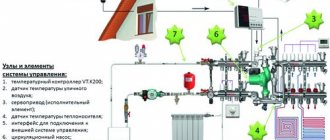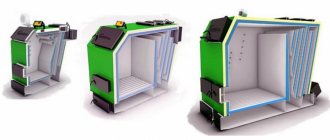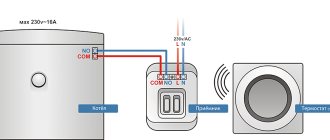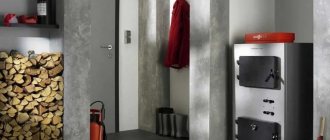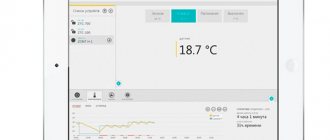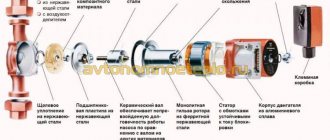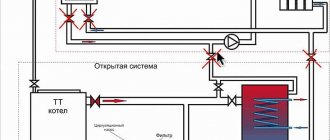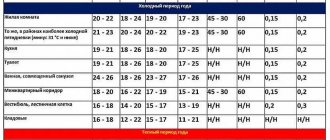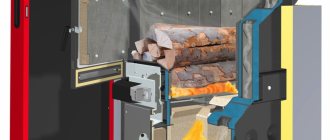Design and principle of operation
The gas boiler is controlled via GSM using a small-sized GSM module. Of value are universal devices that can interact with several models of units, for example, the domestic Telemetrics module is capable of functioning with a dozen boiler units of Russian and Western production. The module organizes the transfer of data on the performance of the unit and thermal conditions in the house using SMS messages or through software applications.
The GSM agent performs remote control of the boiler operating modes, so the house will be heated with a preset internal air temperature when the residents arrive, and in their absence, the rooms will be heated in standby mode. The advantage of such control is that it is implemented by one responsible person, using constant access to the current operating parameters of the heat supply system.
The installation of a GSM thermostat is capable of taking over control of the thermal processes of the boiler, and user access to it is possible from any region of the planet equipped with mobile communications. Modern gas boilers are a complex of complex interconnected systems; incorrect regulation of even one parameter will cause an emergency when operating expensive equipment.
Modern units are produced non-volatile. Even if the owner receives a signal that the power or water is turned off in the house, he will be able to quickly respond online to prevent accidents.
Popular models according to user ratings
The list includes popular models on the Russian market with the optimal combination of price and quality:
- Xital GSM with modifications 4T, 8T and 12T - the numbers indicate the number of zones/rooms that can be controlled. The device is suitable for any boiler, the cost is from 8 to 10 thousand rubles.
- Sapsan Pro 6 for any boiler equipment, you can link up to 10 numbers. Cost from 10 to 16,500 rubles.
- Telcom 2 only for De Dietrich, allows connection of up to 5 numbers.
- The GSM module from Teplocom is suitable for any heating system and requires minimal settings. They ask from 6,000 rubles.
- Vitocom 100 only for Viessmann, a maximum of two numbers can be connected. The price varies from 26 to 30 thousand rubles.
- Logomatic PRO GSM only for Buderus (more often used for floor-standing boilers), the maximum number of numbers is 16. This model will cost 30,000 rubles.
When choosing, focus on how much equipment you want to control, what power it is, what additional indicators you want to connect and the characteristics of the thermal regime in the room.
Rating: Manufacturers and models of GSM modules
A mobile phone can be used as a remote control in a remote access system. To do this, just insert the SIM card into your mobile phone and connect it to the boiler.
Each device contains instructions for use, as well as instructions for installing the module
To purchase such a module yourself, it is recommended to pay attention to the rating. It presents a selection of models for home use from various manufacturers. In addition to them, devices from the companies Wolf, Baxi, Buderus, Navien, Protherm, Vaillant are considered good products.
"Kotel OK"
The most popular on the market, one of the best and most inexpensive GSM modules for heating boilers made in Russia. In addition to the price, it is distinguished by its compact size, extremely simple and easy setup, and the presence of an application that can send commands, including in the form of SMS, which is an excellent option that allows you not to use tariffs with Internet access.
The functionality of the device is quite simple, the minimum required: temperature control, setting alerts, checking boiler operating parameters, and the module also has a built-in relay that allows you to turn the boiler on and off.
Among the disadvantages, it is worth noting a rather simple application with the minimum required functionality and an outdated interface, the presence of an external temperature sensor with a cable length of only 0.5 meters, which does not imply its installation in other rooms remote from the boiler room. The antenna is also not remote, screwed into the device via a threaded connection.
Cost: 3,990 rub.
XITAL GSM 4T
Another well-known, more professional and versatile device with a much richer package. The heating control functionality in it is approximately the same as in the previous “Boiler OK” - the minimum required, however, there are as many as 4 zones for additional devices (flow sensor, smoke sensor, motion sensor, flood sensor, door opening sensor, etc.). Also included is an electronic key and a reader (similar to those installed in intercoms), so you can influence the settings, if desired, only with an electronic key.
The main difference is the presence in the kit of two remote temperature sensors with a wire length of 10 m, as well as a remote wired antenna and a cord for connecting a backup external battery (unfortunately, there is no built-in one). Management and control can be carried out both via SMS and through the application.
The disadvantages, in addition to the lack of a built-in battery, are the ineffective and inconvenient, although understandable, application interface, less attractive appearance with exposed terminals and large dimensions. Please note that for heating you must choose a model that has a “T” at the end.
Cost: 8,640 rub.
EVAN GSM CLIMATE
Also known as ZONT H-1, it features a more modern and convenient application, with ready-made “Economy” and “Comfort” modes, as well as the ability to program boiler operating parameters. It is enough to configure the boiler operating pattern once and the module will automatically issue commands to the boiler to change parameters depending on the time or day of the week. Control via a web interface is also available. The standard package includes one remote temperature sensor and a remote antenna.
Perhaps the only drawbacks are the lack of a built-in battery and only one contact for connecting an external temperature sensor.
Cost: 6,780-8,840 rub.
ZONT H-1V
A more advanced analogue of the previous GSM CLIMATE (ZONT H-1). Despite its less attractive appearance, it has an additional “Anti-Freeze” mode and a built-in battery for autonomous operation during power outages. Number of connected temperature sensors – up to 10 pcs.
Otherwise, due to the same firmware, everything is similar to the previous model: the same control via SMS, application or web interface, which, by the way, is one of the most convenient and functional, with statistics. The kit still includes one remote temperature sensor and a remote wired antenna.
Cost: 7,400-9,200 rubles.
Which heating systems can be controlled remotely
There are practically no system restrictions on the types of heating equipment in order to implement GSM boiler control. The only restrictions are related to the fuel on which the unit runs. This control model is suitable for gas, liquid fuel and electric boilers that have the technical ability to establish a 100% level of automation. Units operating on solid fuel, due to the inertia of thermal processes in the furnace, do not yet have such a level of regulation.
Modern country houses are most often heated using a closed two-pipe heating circuit with floor and room heat control. This is achieved through the use of a circulation pump and a hydraulic boom. The heat supply complex is equipped with a reliable protection module that works with several emergency sensors: gas pressure, flame separation from the burner, unacceptable coolant temperature, pressure limit in the heating and gas mains.
Heating control via GSM - control systems provide:
- Standard temperature operating conditions, maintaining sanitary temperature in the house;
- zone heating: children's room, bathroom, bedroom, living room, kitchen, utility room;
- standby heating to preserve pipes with a water medium from hypothermia during the cold season;
- pre-heating of the facility before the arrival of residents or their guests;
- mode with a daily breakdown of heating quality, which is more preferable: night-day.
Control Features
This scheme allows for weather-dependent control of home heating. Today, this direction is the most promising in the household energy sector, as it allows you to save significant amounts of energy and finances.
To implement it, an additional sensor for external control of air temperature is introduced into the circuit. A weather-dependent controller, working with two temperature sensors - external and internal air, provides finer control of heating processes, which reduces the level of system inertia and low specific costs for generating one unit of thermal energy.
To implement the mobile system, programs have been released to control a gas boiler via smartphones running both Android and Apple software. They present the user with the entire process of controlling the boiler unit as completely as possible, with visual effects and good graphics. For Java devices and simple phones, the scheme operates by sending SMS. Installation of the GSM module can be performed by a trained user, following the factory recommendations. In addition, it is possible to contact the service department of the manufacturer of such devices for advice.
If a mansion or house has a stable Internet connection with a Wi-Fi router, then it is more practical to install remote control of the boiler unit via a PC. Why will you need to use special equipment? equipment:
- Internet gateway connected to the router;
- receiving device on the boiler unit;
- 2-channel thermostat with mode programmer;
- boiler remote control via GSM.
This control scheme allows:
- Perform adjustments to the operating modes of the unit and additional equipment.
- Install zone-by-zone adjustment.
- Set the DHW temperature.
- Adjust the operation of the air conditioner.
- Launch energy-saving modes of equipment operation.
- Perform remote control via an internal communication line between primary devices and signal receivers.
Additional Information! To implement a GSM regulation scheme via the Internet, you will need a computer or any mobile devices with GSM transmission capabilities that will transmit signals through a router that communicates with primary sensors and a control receiver.
Options for controlling the boiler via smartphone
Three solutions are available for remote control of a domestic gas boiler:
- GSM module connection;
- use of a “smart thermostat” via WI-FI communication;
- installation of thermostats.
Each remote control method is good in its own way, and its choice depends on several factors: availability of the Internet, gas boiler model, financial capabilities.
Let's consider all three options - one of them may suit you, and as a result of a partial upgrade, managing the heating system will become much easier.
Option #1 – connecting the GSM module
This is the most common solution, applicable even in areas not covered by the Internet.
The gas boiler is controlled using a GSM unit - a compact controller module. A SIM card is inserted into it, which personalizes the owner and makes it possible to keep in touch with remote equipment
In order to save money, the homeowner can choose the most suitable cellular operator and favorable tariff.
The GSM module is programmable and its operating principle resembles a computer with limited functions. This block is connected to sensors installed both in equipment and in the environment - in rooms, on the street. Depending on the parameters produced by the sensors, the gas unit automatically changes the program or is controlled from a smartphone.
To communicate with the control unit installed in the house, you will need any electronic device - a laptop, tablet, but it is most convenient to use a smartphone, which is more compact and versatile
For ease of control, selection of modes and programs, developers have created applications for various operating systems: iOS, Android, Windows Phone.
There are several modes by which a gas boiler is controlled:
- Fully automatic control. The unit operates according to the specified parameters entered into the program in advance. If changes are required, the program should be adjusted.
- Transmission of alarm notifications in the event of emergency or repair situations. If there is a gas leak or the boiler suddenly stops working, a signal is sent to the smartphone.
- “Communication” using SMS messages. There is a list of commands that the automatic gas boiler recognizes and then makes changes to the operation of the equipment.
- Advanced management options. Using a special program, you can control all systems connected to the GSM unit.
The advantage of remote control via mobile communication is considered to be almost constant control and unlimited possibilities, depending only on the selected application and installed equipment.
A few more advantages of using a GSM module:
Image gallery Photo from Depending on the modification of the unit, you can connect several mobile phones to the module, and then from 2 to 10 people will be able to monitor the operation of the unit. In addition to the gas boiler, sensors installed in various rooms heated by the boiler can be connected to the module: in the kitchen, in the hall, bedrooms and even in the basement or attic In addition to the controller, key reader, antenna, sensors and power supply, you can connect a microphone, gate control unit and other “smart” devices By installing temperature sensors outside, you can set automatic mode changes depending on weather conditions Monitoring the operation of the boiler by all family membersConnecting additional sensors to the program Possibility of connecting basic or extended configurationsAutomatic operation of “weather” sensors
Problems can happen if the cellular connection is poor. The homeowner needs to carefully monitor the expenditure of funds - if the balance is negative, the ability to control the heating equipment will be interrupted.
Option #2 - using the Internet
If the Internet network extends to the area with your country home, then you can control the gas boiler using it.
A WI-FI router is installed in the house, and an Internet thermostat is connected to the boiler equipment. He is the link between the owner of the building and the heating equipment
As soon as the temperature in the room drops below normal, the sensor transmits a signal to the receiver, which interacts with the boiler and turns on the desired heating mode.
The user can control the entire process from a smartphone, monitor changes, and make adjustments. The provider acts as an intermediary between the home owner and the equipment. For continuous communication, it is important to provide access to the Internet both in the home and at the user’s location.
The advantage of the system is the unlimited number of gas boiler sensors - the heating level can be adjusted in all areas served by the building’s heating system.
As with remote control of a gas boiler via a GSM module, the homeowner can control the heating process remotely and make relevant changes. It is possible to install a program that changes the boiler operating mode depending on the time of day, days of the week, and season.
Thermostats, the operation of which depends only on the stability of the Internet connection, are different, but their operating principles are similar.
What happens if the temperature in the house is not controlled when leaving?
If you leave the temperature uncontrolled for a couple of days, no special problems are expected. However, this does not apply to trips lasting 4 or more days. The remote temperature control system sets different scenarios for maintaining the microclimate in the room under different conditions. The option is suitable for a temporary program, a long absence of the owner, or a banal opening of a window.
Lack of temperature control will lead to fluctuations in humidity levels, and as a result: favorable conditions for harmful microorganisms, damage to furniture, floor coverings, and even flowering of microcircuits. Using our software and hardware, the user can easily adapt the microclimate of his home to his own needs. As the popularity of remote control systems has grown, equipment manufacturers have developed services for remote optimization of energy consumption of heating equipment. Therefore, you don’t have to worry about saving resources.
How to choose a GSM module, what should you take into account?
Devices running on the Gsm platform can be purchased both in city stores and on well-known trading platforms such as Aliexpress. Before buying such a module, you should decide what capabilities are expected from it? For example, whether the length of the antenna cable to be connected is important, as well as how many telephone numbers can be used at the same time. When choosing a module, you should consider the following factors:
- number of control zones;
- availability of outputs for connecting sensors of different purposes;
- the ability to expand functionality by updating the device’s firmware;
- the presence of a relay through which feedback is provided;
ability to monitor temperature and send readings to a mobile phone
A good module has adjustable temperature modes and response thresholds.
With its help, you can remotely control the operation of the boiler and make changes to the temperature. A high-quality device will make it possible to change power indicators, and will also instantly send an SMS notification about the activation of emergency sensors.
Programmers and thermostats are the main heating control elements
Heating programmer
To organize autonomous heat supply, you will need electronic devices. They may have a heating boiler control panel and the ability to simultaneously change steam meters in several connected components.
These devices are called programmers or electronic thermostats. Like other similar devices, they can have heating control via SMS or the Internet. But these are just additional functions. To select the optimal model, you need to know the basic functional qualities of the programmer:
- Number of connected circuits . Can vary from 1 to 12. An additional module is installed to increase the number of connectors;
- System operating modes . Depending on the settings, you can set the control of heating radiators in economy, normal and comfortable modes;
- Plug-in module – heating control by phone . The GSM station transmits the required information via SMS - coolant temperature, emergency mode notification, etc.;
- The presence of radio transmitters to create wireless communication channels between connected heating components.
Collectively, the installed equipment is called the heating control frame. It may consist of components with different functionality. The purpose remains the same - the ability to automatically or semi-automatically change heat supply parameters.
Connecting the programmer to the boiler
But in addition to local devices, there are also zonal ones that are installed on specific components - boilers, radiators. By controlling heating via the Internet using these devices, you can regulate the degree of water heating in the system and the temperature regime in a specific battery. Often such devices are called not programmers, but electronic thermostats.
They are more affordable and easy to install. Thermostats do not require a heating control cabinet, which reduces the complexity of installation. In some cases, it is possible to connect several thermostats to a single control unit.
What should you consider when creating a smart heating budget? In addition to the cost of the control element, you need to know the approximate price of consumables - communication wires, heating control panel. The latter is necessary when installing a system consisting of several blocks - a programmer, a GSM module, expansion strips for additional contactors.
| Model | Purpose | Cost, rub. |
| Computherm Q3 | Wired thermostat | 1625 |
| Computherm Q3 RF | Wireless thermostat | 3367 |
| PROTHERM Kromschroder E8.4401 | Programmer. Control of 4 boilers, DHW, 15 heating circuits | 34533 |
| Heating control panel | RCD, boiler control units, connection to temperature sensors | From 7000 |
It is also important to consider the location - the heating control box should be installed in an accessible place. Its installation in a boiler room is not recommended, although this is the simplest option in terms of labor intensity. It is best to install it in a living room. Then it will be possible to monitor and change system parameters much more often.
Programmer models differ in the number of connected system components. They are called control circuits.
Modules for remote control of heat supply
Heating control modules
To organize a home heating control system, you need to take care of the possibility of remote control. Special modules will help provide this function. Most often, they are not included in the standard package of programmers and thermostats.
After purchasing a home heating control unit, you should choose the right communication device. Depending on the technical requirements, it can provide the following types of communication between the user and the control element:
- GSM control . Data is transmitted using cellular communications. In fact, this is a landline telephone with the functions of generating, sending, receiving and processing SMS messages;
- Connection via the Internet . It is characterized by more expanded functionality and is practically not limited geographically. In this case, the heating boiler control panel can be a tablet, laptop or any PC with a special software package installed.
To do this, the programmer must have flexible settings. Arduino heating control systems have this capability. In fact, they can be adapted for any scheme, from ventilation control to complex production complexes.
When traveling abroad, it is not recommended to activate roaming to control heating via the GSM module. This will entail large costs. It is best to entrust control of the heat supply to a friend or relative.
GSM boiler control unit
GSM data transmission unit
The simplest and relatively affordable way to control the operation of the boiler is to install heating control via SMS. For this, a separate unit is purchased, which is connected to a programmer or thermostat. Some models already have a similar function.
At the stage of choosing a remote heating control, you should decide on the method of data transmission via the GSM network. This largely depends on the capabilities of the specific phone model, as well as the built-in functions of the data transmission unit.
The easiest way to receive messages is in the form of SMS. The unit installed in the heating control frame will transmit the following data:
- A drop in temperature and pressure below (above) a critical level;
- Emergency failure of the boiler - power outage, lack of energy. In this case, it is possible to transmit the error code and its description.
A unit with a built-in SMS notification module.
To reverse control the heating by phone, you need to send SMS of a certain format. With their help, you can adjust the temperature level and initiate the startup of the boiler after an emergency shutdown. Also, many models have a built-in command delay function. Those. the value of a parameter is transmitted, and the activation time of the boiler to achieve it is indicated.
It is important to remember that the data obtained may differ from the actual data. To effectively control heating radiators, it is necessary to know the degree of error of the following devices:
- Temperature sensors . The readings of most electronic models have an error of ±0.5°C;
- Temperature change step in the thermostat . It can range from 0.2°C to 0.5°C.
In practice, this is really necessary when setting the heating to anti-freeze mode, when the heating level of the coolant is maintained at +5°C. This allows you to save on energy costs and at the same time avoid emergency situations.
To install the GSM unit, you do not need to purchase a special heat supply control cabinet. This device is rarely controlled, so you can limit yourself to installing a closed switchboard.
Heating control via the Internet
Receiving heating data on a smartphone
Controlling heating via the Internet has all the advantages inherent in controlling heat supply using SMS messages. However, the ability to receive more information affects the quality of heat supply.
The functions of the cottage heating control unit when connected to the Internet have a number of advantages. The main one is the ability to install special software systems. They are integrated into a laptop, smartphone or any other type of personal PC. At the same time, remote control of heat supply has the following capabilities:
- User-friendly interface . Most often it is designed for smartphone operating systems. But with a little modification it can be installed on a computer;
- There is no limit on the number of connected users , as in SMS blocks;
- Ability to configure settings from any point where there is Internet. In this case, there is no need to enable roaming. The exception is Internet services from mobile operators.
It is important to correctly preset the remote control for the heating boiler. To do this, it is recommended to first check the actual readings of the system after they have been changed. This is necessary to calibrate the system.
Some models of Internet blocks installed in the heating control frame have operating system restrictions. The most commonly used OS is Android or IOS.
Tips for organizing remote heating control
Diagram for connecting modules to the heating control unit
In most cases, you can make a cottage heating control system yourself. This is only possible with the correct selection of system components. Those. First you need to analyze the condition and capabilities of the already installed equipment.
The classic heating system control unit diagram has one control unit, which is connected to all heat supply elements. The programmer must meet the following requirements:
- The number of connected terminals and their configuration must coincide with similar communication nodes of the boiler and thermostats. Otherwise, heat supply control via SMS will be impossible. If necessary, adapters are purchased;
- Maximum distance of the user from the control unit. If this distance does not exceed 300 m, you can purchase models with mine control. To increase the communication area, it is recommended to use heating control via a mobile phone or the Internet;
- The ability to independently (or with the help of specialists) set additional operating parameters. This is done with a controller based on heating control boards;
- Connecting an autonomous power supply unit. To do this, you need a sufficiently large heating control box. This parameter is taken into account when choosing the installation location of the control unit in the house.
What can a GSM socket be used for?
For example, to turn on some specific devices, say, to keep the refrigerator running. You can turn off the lights throughout the house while leaving them on. Naturally, the outlet to which the “smart” device and equipment are in turn connected must be connected to a separate machine. Or you need to be very careful to ensure that all other electrical appliances in the house are turned off after leaving. By leaving the refrigerator connected to the GSM device, in the event of a power outage, you will immediately receive an SMS notification and, perhaps, have time to save your food. The outlet itself is equipped with a spare power supply.
Another popular application: connecting to a heating system outlet. Before leaving for the dacha, you turn on the heating with one SMS message and arrive to a warm home. You can set the operation so that a certain temperature is maintained in the room, since the outlet is equipped with a corresponding sensor.
In the summer, you can connect an irrigation system to a smart outlet in the same way.
Most sockets on the market are compatible with all major household appliances: the maximum power of connected devices is limited to 3 kW, this is enough to connect even devices such as an electric kettle, air conditioner or oil radiator.
Modulating burners, OpenTherm protocol and weather-compensated automation
Today, the most modern and technologically advanced heating control systems are devices operating under the OpenTherm protocol.
Without going into highly specialized details, we will consider three main features that distinguish equipment with OpenTherm from the one described above.
Feature one: flame modulation control
The emergence of new gas boilers with burners capable of controlling flame modulation has opened up new opportunities in organizing economical and efficient heating. Let us explain that flame modulation is the regulation of heating power. If the power is too high, the boiler switches on and off frequently (clocking), and if the power is low, achieving the set temperature becomes impossible. Those. The best flame modulation is considered to be the combustion level at which the boiler does not turn off and the set temperature value is reached. In other words, flame modulation control is the ability of the boiler automation, depending on external conditions, to optimally change the burning intensity of the burner flame without turning it off. None of the boiler control methods described above can control flame modulation. To work with the new burners, the OpenTherm protocol was invented, which made it possible to effectively combine the functioning of the new burners with the capabilities of “smart” weather-dependent automation and electronics.
Feature two: working with automation
In essence, OpenTherm is a bridge that has been built between boiler manufacturers and manufacturers of other electronics and automation. A single protocol that does not depend on anyone standardly describes all the basic commands for working with modulating burners. This allows you to connect a wide variety of equipment to it: from a thermostat to programmable temperature controllers, to which a large number of temperature sensors can be connected. Modern thermal controllers are programmable devices that are able to process the readings of temperature sensors located both in various zones of a heated facility and on the street. The heat controller maintains a set target temperature value and can change it depending on user commands, time of day or day of the week. Analyzing the received temperature data outside and inside the room, the controller sets a weather-dependent operating mode for the modulating burner of the boiler and pumps (see Fig. 3).
Fig.3. Temperature regulation using the Teplocom Cloud heat informer
On the graph we can see that the burner practically does not turn off, but only changes the intensity of its combustion. At the same time, regardless of external conditions, the target temperature graph changes extremely slightly and lies within the hysteresis limits of the heating system. Additional advantages of this control system are a noticeable increase in the burner's operating life (there are no ignition, rapid heating and cooling cycles), and significant savings in gas fuel are achieved.
Feature three: access to automation settings and error logging
The presence of “smart” control and the existence of feedback between the boiler and the control equipment opens up the third feature of the OpenTherm protocol - the ability to get full access to the boiler automation settings using one protocol and change them from any control device (smartphone). Additionally, access to information about all errors that occurred during the operation of the thermal system is opened, which provides an invaluable tool for personnel servicing and monitoring the operation of the equipment.
pros:
- Minimal fluctuations in air temperature in the house, regardless of the temperature outside, which ensures maximum comfort;
- Minimum fuel consumption compared to other control methods;
- The temperature is adjusted by changing the modulation of the burner flame, which minimizes the number of on/off cycles;
- Possibility of remote monitoring of the boiler condition and changing its settings.
Minuses:
- Higher price compared to other equipment, which is compensated by lower gas consumption.
What are the dangers of high humidity in the house?
Excessively humid air harms furniture and interior items. Even premium quality wallpaper often changes color, becomes moldy, or peels off. The plaster can become completely damp, falling off in pieces. Simply put: expensive repairs will go down the drain.
Dampness even penetrates into closets and chests of drawers. Therefore, when humidity is high, items made of wood, leather and paper are the first to suffer. The worst thing about high humidity is that it creates a haven for mold and mildew. In a damp room, these microorganisms multiply quickly. Fungi and mold enter the human body with oxygen. Minimal harm from mold and fungi - runny nose and allergies. In the worst case, chronic diseases worsen. Both adults and children are at risk.
Heat informator TEPLOCOM CLOUD
In this article we looked at the main ways to control a heating boiler - from manual to automatic, using modulating burners with OpenTherm. One of the modern devices that are capable of implementing the latest technologies for controlling the heating system is the TEPLOCOM CLOUD . This is an electronic device whose expanded functionality goes far beyond simply maintaining a stable temperature in the house. Based on “cloud technology”, it implements a mechanism for transmitting information from connected equipment and remotely controlling it via a smartphone.
TEPLOCOM CLOUD - the heat of your home is always under control!
Capabilities of the TEPLOCOM CLOUD heat information device:
- Informing about accidents and the condition of the heating system. Control the boiler via a smartphone from anywhere in the world.
- Constant monitoring of the condition of the gas boiler, the temperature outside and in the house, the temperature of the coolant, the occurrence of leaks, the presence of a 220V network. It is possible to connect contact sensors for additional notification.
- The temperature is controlled depending on the outside temperature using WeatControl technology, which minimizes temperature fluctuations in the house during the day.
- Individual schedule of comfortable temperature for the whole week.
- Possibility of placing up to 10 wireless temperature sensors within a radius of 300 meters.
- Reducing gas consumption by up to 30% and combating harmful emissions into the atmosphere by reducing the carbon dioxide produced.
- Free applications for working with TEPLOCOM CLOUD on Android and iOS.
- The delivery set includes: heat informer, wireless radio temperature sensor, leakage sensor, outdoor temperature sensor, coolant temperature sensor, GSM SIM card, built-in Li-ion battery.
Thanks to WaetControl technology, the heating system is controlled taking into account changes in the weather outside. Which minimizes temperature fluctuations in the house during the day.
Thus, we see that there are a large number of devices that ensure the operation of thermal systems with varying degrees of comfort and efficiency. The choice of the best one, as always, remains with the consumer.
How a smart plug works
“Communication” with a simple socket is carried out via SMS commands, so a SIM card is required for operation. The control unit contains a set of commands that are executed after receiving a code message. So, for example, most often an SMS command with code #01# turns on the socket, and with code #02# turns it off. To prevent strangers from interfering with this process, during initial activation, telephone numbers (usually no more than 5) from which commands will come are entered into memory using a special code. So, accidentally or specially sent commands from other numbers will not be executed by the socket. In addition, one of the numbers is designated as the main one, and all messages about changes in the state of the outlet are sent to it.
If you are not comfortable receiving SMS, you can control it by simply calling the device or installing a special mobile application. Unfortunately, not all sockets can be controlled via mobile applications yet, but this is becoming increasingly popular.
